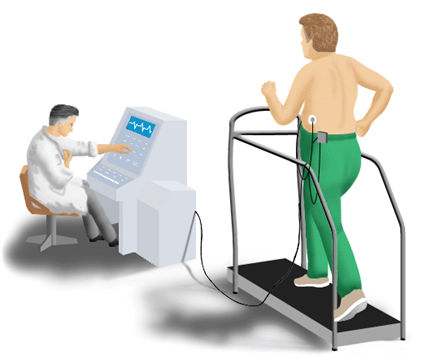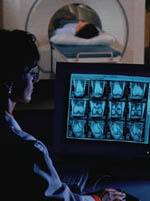Myocardial Perfusion Scan, Stress
What is a stress myocardial perfusion scan?
Myocardial perfusion is an imaging test. It's also called a nuclear stress test. It is done to show how well blood flows through the heart muscle. It also shows how well the heart muscle is pumping. For example, after a heart attack, it may be done to find areas of damaged heart muscle. This test may be done during rest and while you exercise.
A myocardial perfusion scan uses a tiny amount of a radioactive substance, called a radioactive tracer. The tracer travels through the bloodstream and is absorbed by the healthy heart muscle. On the scan, the areas where tracer has been absorbed look different from the areas that do not absorb it. Areas that are damaged or don't have good blood flow do not absorb the tracer. The damaged areas may be called “cold spots” or “defects.”
A stress myocardial perfusion scan assesses blood flow to the heart muscle when it is stressed. The heart is usually “stressed” from exercise. But, if you are unable to exercise, the heart can be stressed by taking a certain medicine that increases your heart rate or dilate blood vessels as would occur during exercise.
After the radioactive tracer is injected, a special type of camera is used that can detect the radioactive energy from outside the body. The camera takes images of the heart during stress and again later at rest. The two sets of images are compared.
Other related procedures that may be used to diagnose heart disorders include exercise and resting electrocardiograms (ECG or EKG), Holter monitor, signal-averaged ECG, cardiac catheterization, chest X-ray, computed tomography (CT scan) of the chest, echocardiography, electrophysiological studies, magnetic resonance imaging (MRI) of the heart, radionuclide angiography, and cardiac CT scan.
Why might I need a stress myocardial perfusion scan?
Your doctor may order a stress myocardial perfusion scan for:
-
Chest pain, either new onset or occurring over a period of days or longer
-
To diagnose coronary artery disease (CAD), which is the narrowing of the coronary arteries
-
After a heart attack (myocardial infarction, or MI) to assess heart muscle damage
-
To assess blood flow to areas of the heart muscle after coronary artery bypass surgery, angioplasty, or stent placement.
There may be other reasons for your healthcare provider to recommend a stress myocardial perfusion scan.
What are the risks of a stress myocardial perfusion scan?
Risks of the scan may include:
-
The exercise part of the test may lead to rare instances of abnormal heart rhythms, chest pain, or heart attack due to the stress on the heart caused by the exercise.
-
The needle used to put in the IV may cause some pain. The injection of the radioactive tracer may cause some slight discomfort. Allergic reactions to the tracer are rare.
-
If your heart is stressed using medicine, you may feel anxious, dizzy, nauseous, shaky, or short of breath or chest pain for a brief period.
You may want to ask your healthcare provider about the amount of radiation used during the procedure and the risks related to your particular situation.
There may be other risks depending on your specific medical condition. Be sure your healthcare provider knows about all of your medical conditions.
Make a list of questions you have about the procedure. Be sure to discuss these questions with your healthcare provider before the procedure. Bring a family member or friend to the appointment to help you remember your questions and concerns.
Certain factors may interfere with or affect the results of this test. These include:
-
Use of medicines containing theophylline
-
Caffeine intake within 48 hours of the procedure
-
Smoking or using any form of tobacco within 48 hours of the procedure
-
Certain heart medicines, such as those that slow the heart rate
How do I prepare for a stress myocardial perfusion scan?
PLEASE NOTE: Certain factors or conditions may interfere with or affect the results of the test. These include, but are not limited to, the following:
-
Medications containing theophylline
-
Caffeine within 24 hours of the procedure
-
Nitrate medications
-
Medications that slow the heart rate
-
Notify your doctor and when you schedule the exam if you have a pacemaker
PRECAUTIONS: If you are pregnant or think you may be pregnant, please check with your doctor before scheduling the exam. We will discuss other options with you and your doctor.
BREASTFEEDING: If you are breastfeeding, you should notify your health care provider due to the risk of contaminating breast milk with the tracer.
CLOTHING: You may be asked to change into a patient gown. A gown will be provided for you. Lockers are provided to secure your personal belongings. Please remove all piercings and leave all jewelry and valuables at home. Plan to wear loose, comfortable clothing for the exercise portion of the test, as well as a comfortable pair of shoes.
EAT/DRINK: Fasting may be required before the procedure. Your doctor will give you instructions as to how long you should withhold food and/or liquids.
If you are scheduled for a pharmacologic myocardial perfusion scan, you will need to avoid taking any medications containing theophylline or caffeine. Coffee, even decaffeinated, is not allowed, as it contains some caffeine. Medications for asthma may contain theophylline. If you have asthma, inform your doctor. Theophylline medications should be stopped 48 hours prior to the test. Medications that contain caffeine and all food and drink containing caffeine should be held for 12 to 24 hours. Some over-the-counter medications that contain caffeine include Anacin, Excedrin and NoDoz. Consult your doctor for specific instructions.
ALLERGIES: Notify the radiologist or technologist if you are allergic to or sensitive to medications, contrast dyes or iodine. The injection of the radiotracer may cause some slight discomfort. Allergic reactions to the radiotracer are rare, but may occur.
MEDICATIONS: Please bring a list of all medications (prescription and over-the-counter) and herbal supplements that you are taking.
Based on your medical condition, your doctor may request other specific preparation.
What happens during a stress myocardial perfusion scan?
You may have a stress myocardial perfusion scan on an outpatient basis or as part of your stay in a hospital. Procedures may vary depending on your condition and your healthcare providers practice.
Generally, a stress myocardial perfusion scan follows this process:
-
You will be asked to remove any jewelry or other objects that may interfere with the procedure.
-
If you are asked to remove your clothing, you will be given a gown to wear.
-
An intravenous (IV) line will be started in your hand or arm.
-
You will be connected to an electrocardiogram (ECG) machine with leads that stick to your skin and a blood pressure cuff will be placed on your arm.
Exercise myocardial perfusion scan:

-
You will exercise on a treadmill. The intensity of the exercise will be gradually increased by increasing the speed of the treadmill.
-
Your heart rate and blood pressure will be monitored. Once you have reached your maximal exercise point (determined by the healthcare provider based on your heart rate and age), the radioactive tracer will be injected into your IV line.
-
After the tracer has been injected, you will continue to exercise for several minutes.
-
You will then be placed into the heart scanner so images can be taken.
Pharmacologic myocardial perfusion scan:
-
You will not exercise on a treadmill. Instead, you will lie on the table in the heart scanner while a medicine is injected into your IV.
-
Your heart rate and blood pressure will be monitored.
-
The tracer will be injected into your IV line.
Procedure completion, both methods:
-
If you have any symptoms such as dizziness, chest pain, extreme shortness of breath, or severe fatigue at any point during the procedure, let the healthcare provider or technologist know.
-
You will lie flat on a table while the images of your heart are taken. About 10 to 60 minutes (depending on the type of tracer used) after the tracer is injected, the gamma camera will begin to take pictures of your heart. In this special kind of test called SPECT (single photon emission computed tomography), the scanner rotates around you as it takes pictures. The table slides into the hole of the scanner, which is a large, donut-shaped machine.
-
Your arms will be on a pillow above your head. You will need to lie very still while the images are being taken, as movement can affect the quality of the images.
-
After the scan is completed, you may be allowed to leave the area, but will need to return for a second set of scans. The second set of scans will be taken 3 to 6 hours after the first set. During this time, you will not be allowed to eat or use tobacco and will be allowed limited water or decaffeinated/non-calorie liquids. In some cases, your healthcare provider may decide to have you return on another day for the second set of scans.
-
The second set of scans will be much like the first set, but you will not need to exercise or get the medicine. You will lie on the table as before while the scanner takes pictures of your heart.
-
Once the second set of scans has been completed, the IV line will be removed, and you will be allowed to leave, unless your healthcare provider tells you differently.
What happens after a stress myocardial perfusion scan?
Move slowly when getting up from the scanner table to avoid any dizziness or lightheadedness from lying flat for the length of the procedure.
Drink plenty of fluids and empty your bladder often for 24 to 48 hours after the test. This helps flush the remaining radioactive tracer from your body.
The IV site will be checked for any signs of redness or swelling. If you notice any pain, redness, or swelling at the IV site after you return home, tell your healthcare provider. This may be a sign of infection or other type of reaction.
Your healthcare provider may give your other instructions after the procedure, depending on your particular situation. If the perfusion scan shows you may have a serious or life threatening cardiac disease, your healthcare provider may talk to you about a same-day cardiovascular procedure.



